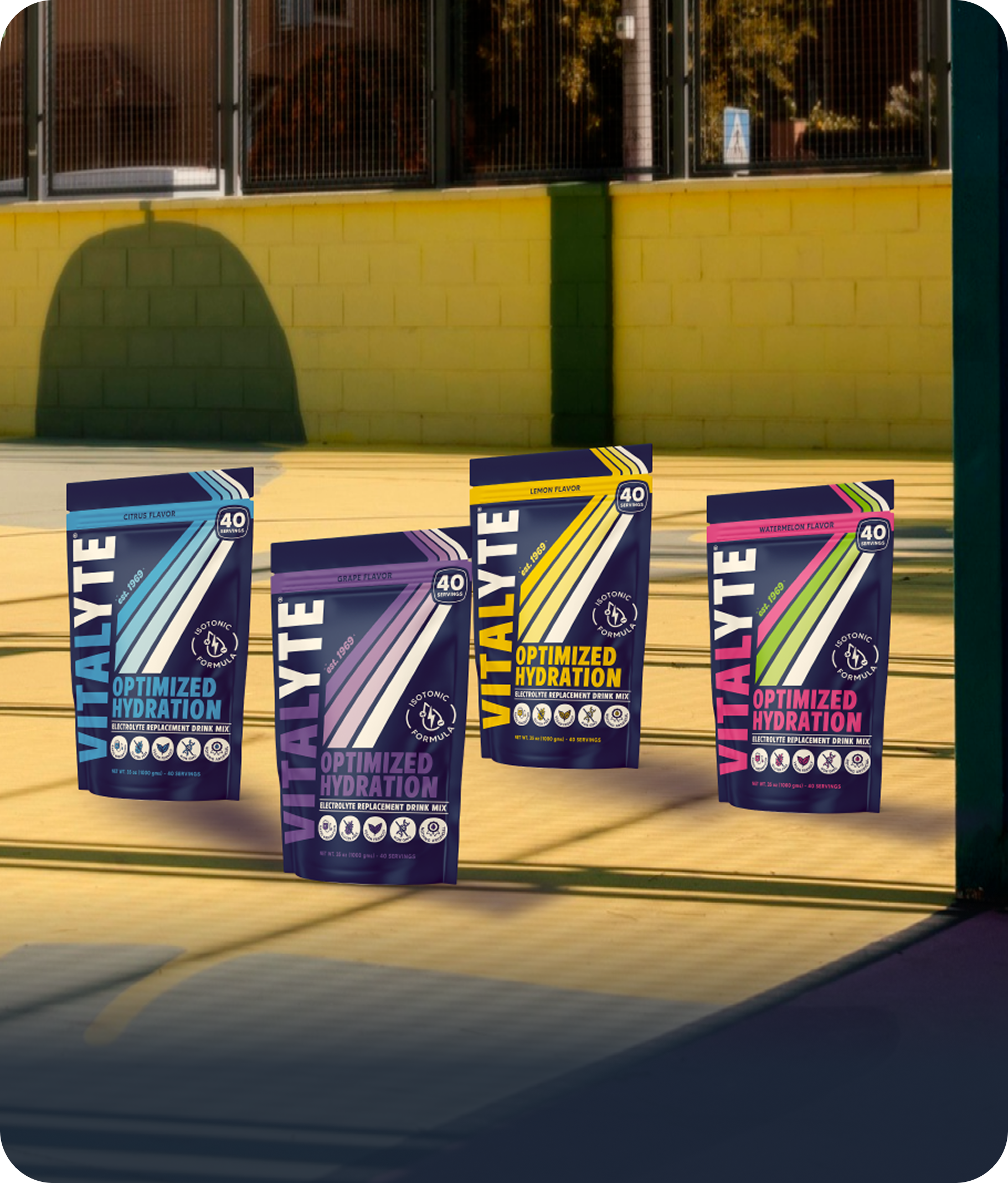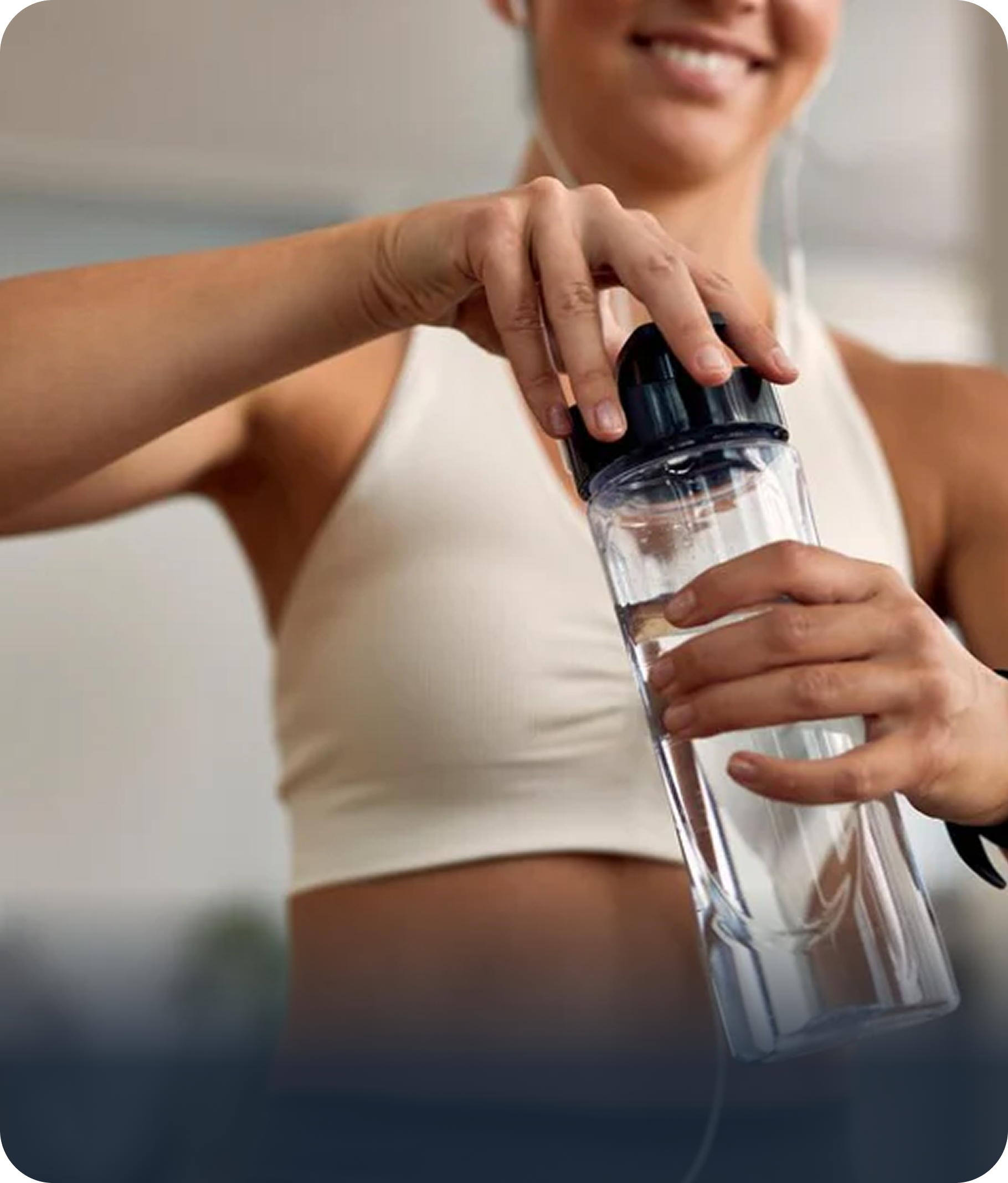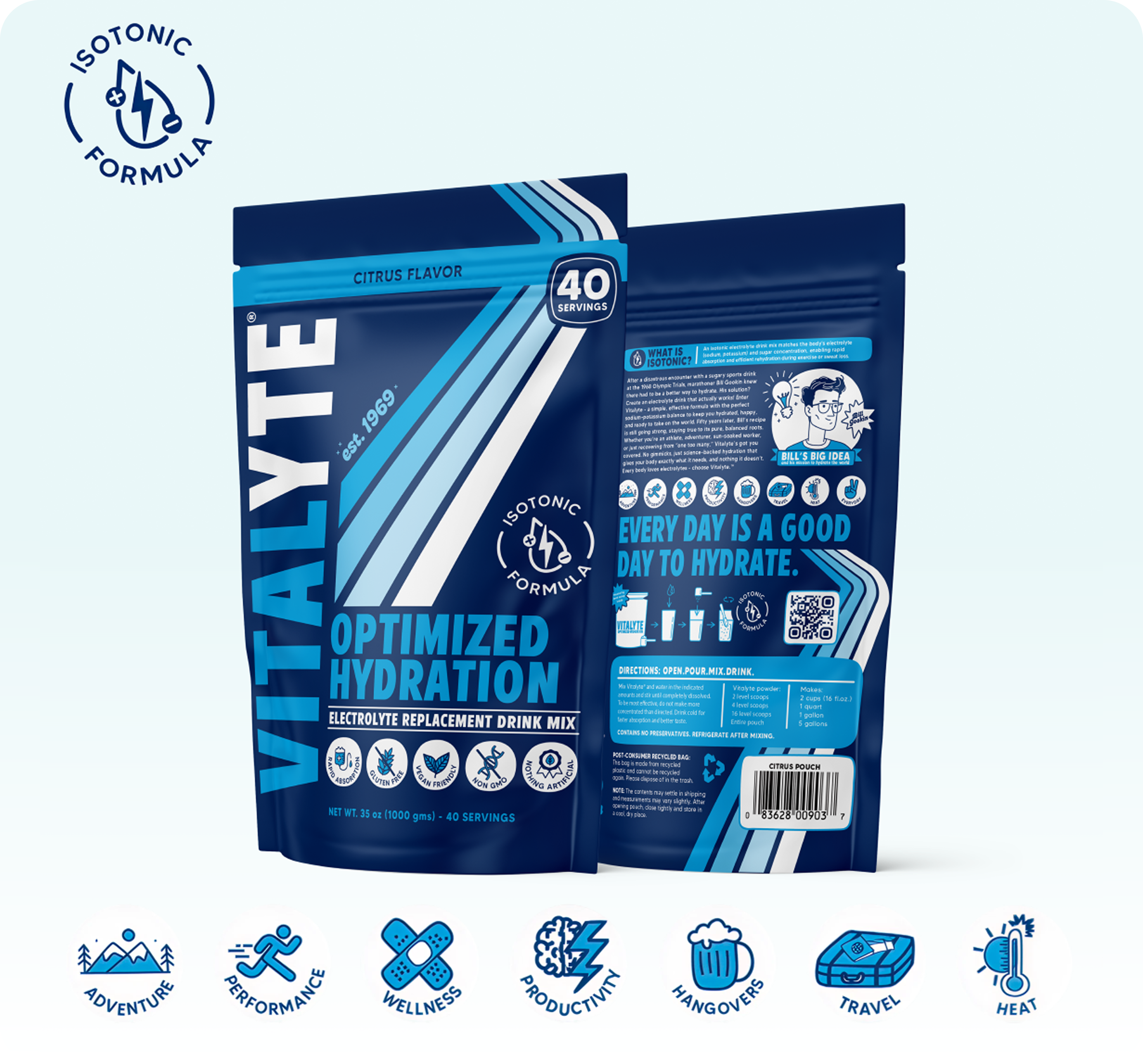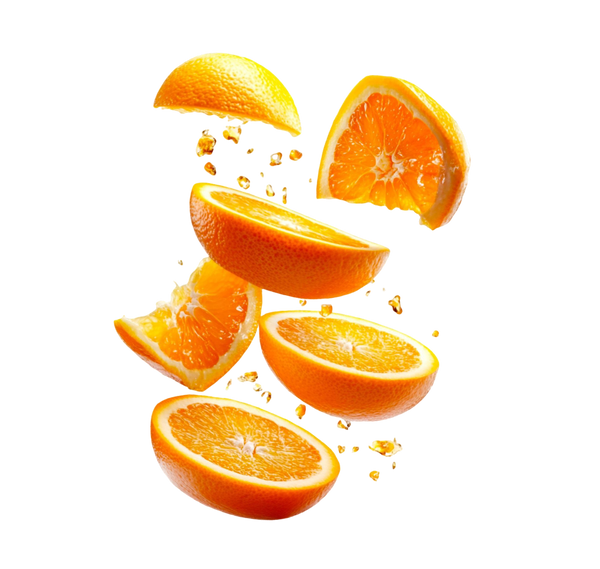Vitalyte vs LMNT vs Drip Drop vs Liquid IV vs Pedialyte: The Honest Electrolyte Powder Comparison
Share

Most electrolyte powder comparisons are written by affiliate bloggers who've never tried the products. They rank whatever pays the highest commission and call it "research."
This comparison is different. We're going to be brutally honest about what each major brand does well, where they fall short, and most importantly, who each formula is actually designed for. That includes being transparent about when Vitalyte isn't your best choice.
Why trust this comparison? Because we have nothing to gain from misleading you. Vitalyte has been making the same isotonic formula since 1971. We're not chasing trends or pivoting to whatever's hot on Instagram. We know what we do well, we know our limitations, and we know the science behind why formulation matters more than marketing budgets.
Here's what 50 years of athlete feedback taught us: there's no single "best" electrolyte powder. There are formulas optimized for different goals, different diets, different use cases. The keto athlete training in Phoenix needs something different than the recreational marathoner in Seattle. The medical patient recovering from illness has different requirements than the ultra runner chasing a 100-mile PR.
This guide will help you cut through the marketing noise and choose based on what actually matters: formulation, use case fit, and whether the science backs up the claims.
 Let's start with the comparison table, then we'll dig into what makes each brand unique.
Let's start with the comparison table, then we'll dig into what makes each brand unique.
The Quick Comparison: What You Need to Know
|
Brand |
Type |
Sodium (per 16oz) |
Potassium |
Na:K Ratio |
Carbs |
Osmolality |
Price/Serving |
Founded |
Best For |
|
Vitalyte |
Isotonic |
135mg |
193mg |
1:1.4 |
16g (4%) |
~280 mOsm/L |
$0.65 |
1971 |
Endurance athletes, balanced performance |
|
LMNT |
Hypertonic |
1000mg |
200mg |
5:1 |
0g |
~350+ mOsm/L |
$2.00 |
2018 |
Keto dieters, very high sodium needs |
|
Liquid IV |
Hypertonic |
500mg |
370mg |
1.3:1 |
11g (3%) |
~320 mOsm/L |
$1.50 |
2012 |
Casual hydration, lifestyle use |
|
Drip Drop |
Isotonic |
330mg |
185mg |
1.8:1 |
8g (2%) |
~280 mOsm/L |
$1.20 |
2011 |
Medical recovery, illness |
|
Pedialyte |
Isotonic |
370mg |
280mg |
1.3:1 |
6g (1.5%) |
~270 mOsm/L |
$1.00 |
1966 |
Children, illness, hangovers |
|
Gatorlyte |
Isotonic |
490mg |
350mg |
1.4:1 |
14g (3.5%) |
~290 mOsm/L |
$1.00 |
2022 |
Gatorade loyalists, mainstream appeal |
|
Skratch Labs |
Isotonic |
380mg |
190mg |
2:1 |
20g (5%) |
~295 mOsm/L |
$1.25 |
2012 |
Natural ingredient focus, pro athletes |
|
Nuun |
Hypotonic |
300mg |
150mg |
2:1 |
1g (<1%) |
~240 mOsm/L |
$0.75 |
2004 |
Convenience, light hydration |
Key takeaway from the table: Only four brands (Vitalyte, Drip Drop, Pedialyte, and Gatorlyte) formulate true isotonic drinks around 270 to 300 mOsm/L for optimal absorption. LMNT and Liquid IV are hypertonic, which means slower gastric emptying and potential GI issues during hard efforts. Nuun is hypotonic, which absorbs fast but delivers minimal carbohydrates for sustained energy.
Now let's break down each brand in detail.
Vitalyte: The Original Endurance Formula (1971)
The origin story: Bill Gookin, biochemist and marathoner, bonked spectacularly at the 1968 Olympic Trials after drinking commercial sports drinks. Spent the next 25 years testing formulations on himself and thousands of athletes. Created the isotonic formula that became Gookinaid, renamed Vitalyte in 2007.
The formulation approach:
-
Isotonic concentration (~280 mOsm/L) matching blood osmolality
-
Balanced 1:1.4 sodium to potassium ratio (135mg:193mg per 16oz)
-
4% carbohydrate solution (16g glucose and fructose per serving)
-
Natural ingredients, no artificial sweeteners or colors
What makes it unique: The 50-year testing timeline that no competitor can replicate. This isn't a formula designed by a marketing team in 2018. It's a formula refined through decades of real-world athlete feedback across every condition imaginable: Olympic competitions, ultra-endurance events, Search and Rescue operations, medical missions, construction sites in extreme heat.
The balanced electrolyte ratio prevents the potassium depletion that causes whole-body cramping. While competitors chase the high-sodium trend, Vitalyte maintains the ratio that research shows matches what your body actually loses in sweat and needs for cellular function.
Honest strengths:
-
Proven track record over 50+ years of use
-
Isotonic formulation for rapid absorption without GI distress
-
Balanced electrolytes prevent depletion (not just replacement)
-
Natural ingredients reduce variables during hard efforts
-
Affordable ($0.65 per serving in bulk)
-
Works reliably for the widest range of athletes and conditions
Honest limitations:
-
Not optimized for keto dieters who need massive sodium without carbs
-
Not as trendy or Instagram-friendly as newer brands
-
Moderate sodium (135mg) insufficient for extreme heat + very high sweat rates
-
Taste is "functional" not "delicious" (designed for mile 20, not your couch)
-
No single-serve packets in all flavors (bulk containers only for some)
Best for:
-
Endurance athletes (marathons, ultras, triathlons, century rides)
-
Anyone exercising 60+ minutes at moderate to high intensity
-
Athletes who experience cramping with high-sodium products
-
People who want proven science over marketing hype
-
Budget-conscious athletes who want quality without premium pricing
-
Workers in heat stress environments needing reliable hydration
Not ideal for:
-
Strict keto or carnivore dieters (carbs present, sodium too low)
-
Ultra-high sweat rate athletes in extreme heat (may need additional sodium)
-
People prioritizing taste over function
-
Those wanting trendy packaging for social media
Shop Vitalyte's electrolyte replacement drinks
 LMNT: The High-Sodium Keto Option (2018)
LMNT: The High-Sodium Keto Option (2018)
The origin story: Founded by Robb Wolf (biochemist and NYT bestselling author) and Luis Villasenor. Created specifically for people following low-carb, keto, paleo, or carnivore diets who need massive sodium replacement without carbohydrates.
The formulation approach:
-
Hypertonic concentration due to 1000mg sodium per serving
-
5:1 sodium to potassium ratio (1000mg:200mg)
-
Zero carbohydrates, zero sugar, zero calories
-
Uses stevia for sweetness
-
Aggressive contrarian positioning: "The Salty Rebellion"
What makes it unique: LMNT doesn't apologize for being salty. While every other brand tries to make electrolyte drinks taste like juice, LMNT leans into high sodium and educates consumers about why conventional sodium recommendations are too low for active people, especially those in ketosis.
Their "Salty Science" blog at science.drinklmnt.com provides the deepest scientific content of any electrolyte brand, with extensive literature citations. They're serious about education, not just selling powder.
Honest strengths:
-
Best-in-class educational content and research citations
-
Optimized specifically for keto/low-carb/carnivore diets
-
High sodium (1000mg) addresses needs of those losing extra sodium on keto
-
Zero carbs for strict carb counters
-
Authentic founder story with Robb Wolf's credentials
-
Strong community building in CrossFit and keto spaces
-
Travel-friendly single-serve packets
Honest limitations:
-
Hypertonic formulation (~350+ mOsm/L) slows gastric emptying
-
Research shows hypertonic drinks can reduce plasma volume maintenance during exercise
-
5:1 sodium:potassium ratio can force potassium depletion for non-keto athletes
-
Zero carbs mean no fuel for exercise lasting 60+ minutes
-
Very salty taste not appealing during long, hot efforts
-
Expensive at $2 per serving
-
Can cause GI distress during intense exercise (hypertonic effect)
-
Not ideal for most athletes who aren't on strict low-carb diets
Best for:
-
Strict keto, paleo, or carnivore dieters
-
People who've been keto for months and chronically lose excess sodium
-
Those wanting zero carbs for metabolic reasons
-
Athletes willing to sacrifice optimal absorption speed for dietary compliance
-
People who enjoy very salty flavors
-
Those prioritizing deep scientific content and education
Not ideal for:
-
Endurance athletes needing both hydration and carbohydrate fuel
-
People not following low-carb diets (excessive sodium can deplete potassium)
-
Athletes prone to GI issues during hard efforts (hypertonic = slower emptying)
-
Budget-conscious athletes ($2/serving adds up quickly)
-
Anyone who dislikes very salty drinks
The Vitalyte perspective: LMNT serves a specific niche exceptionally well. If you're deep in ketosis and need massive sodium replacement without any carbs, LMNT makes sense. But for most athletes who eat normal diets and need fuel plus hydration during longer efforts, the hypertonic concentration and zero carbs work against performance. Balanced ratios closer to 1:1 prevent the potassium depletion cascade that high-sodium formulas can trigger.
Liquid IV: The Lifestyle Hydration Brand (2012)
The origin story: Founded with a mission to provide hydration solutions globally. Now owned by Unilever (massive consumer goods corporation). Heavy celebrity partnerships and influencer marketing drive brand awareness.
The formulation approach:
-
Hypertonic concentration (~320 mOsm/L) due to CTT formula
-
Moderate-high sodium (500mg) with good potassium (370mg)
-
1.3:1 sodium to potassium ratio (better than LMNT)
-
11g carbohydrates (3% solution)
-
CTT (Cellular Transport Technology) is rebranded ORS science
-
Added vitamins B3, B5, B6, B12, and C
What makes it unique: Liquid IV owns the lifestyle positioning. This isn't marketed primarily to serious athletes. It's for travelers, festival-goers, busy professionals, hangover recovery, and general wellness. The brand appeals to people who want hydration to feel like a lifestyle upgrade, not a performance tool.
The mission-driven narrative about providing clean water access adds purpose beyond just selling powder. For every purchase, Liquid IV donates to those in need.
Honest strengths:
-
Wide availability (Target, Costco, grocery stores nationwide)
-
Multiple specialized product lines (Hydration, Sugar-Free, Energy, Sleep, Immunity)
-
Good sodium:potassium ratio (1.3:1) compared to LMNT
-
Mission-driven impact story resonates with consumers
-
Appealing flavors designed for casual drinking
-
Celebrity and influencer visibility drives awareness
-
Single-serve packets convenient for travel
Honest limitations:
-
Hypertonic formulation slows absorption versus isotonic options
-
CTT branding is just standard ORS science repackaged
-
Third-party reviews question "hydrates 2x faster than water" claims
-
Contains added sugars (11g) which some avoid
-
More expensive than performance justifies ($1.50 per serving)
-
Optimized for shelf taste, not exercise performance
-
Heavy marketing budget reflected in premium pricing
-
Some flavors use artificial sweeteners despite "natural" positioning
Best for:
-
Casual hydration throughout the day (not during intense exercise)
-
Travelers wanting convenient single-serve packets
-
Hangover recovery and illness rehydration
-
People who prioritize taste over optimal formulation
-
Those drawn to mission-driven brands
-
Social situations where you want hydration that doesn't look medical
-
General wellness users, not serious athletes
Not ideal for:
-
Endurance athletes during long training or racing
-
Anyone prone to GI distress during exercise (hypertonic = bloating risk)
-
People wanting maximum performance per dollar
-
Those avoiding added sugars or wanting clean-label products
-
Athletes needing carbohydrates optimized for sustained energy
The Vitalyte perspective: Liquid IV succeeds at making hydration appealing to mainstream consumers who would never buy a "sports drink." But when you're at mile 18 of a marathon and your stomach is deciding whether to cooperate, the hypertonic concentration that makes it taste great sitting on your couch becomes a liability. Form should follow function, especially during performance.
Drip Drop: The Medical-Grade ORS Option (2011)
The origin story: Founded by Dr. Eduardo Dolhun during humanitarian aid missions where IV therapy was unavailable. Developed as an Oral Rehydration Solution following WHO standards but optimized for palatability and American markets.
The formulation approach:
-
True isotonic formulation (~280 mOsm/L)
-
330mg sodium, 185mg potassium (1.8:1 ratio)
-
8g carbohydrates (2% solution, lower than optimal for athletes)
-
Based on proven ORS science (sodium-glucose cotransport)
-
FSA/HSA eligible (positioned as medical product)
-
Patented formula variations for specific needs
What makes it unique: Drip Drop bridges medical necessity and consumer palatability. It's the only brand that's genuinely positioned as an alternative to IV therapy in medical situations, with doctor recommendations and hospital use. The humanitarian origin story is authentic, not marketing fluff.
Research shows ORS formulations like Drip Drop's work by leveraging SGLT1 transporters to enhance fluid absorption beyond what water alone provides.
Honest strengths:
-
Legitimate medical credentials and doctor recommendations
-
Isotonic formulation for rapid absorption
-
FSA/HSA eligible (medical expense qualified)
-
Trusted by first responders, military, medical teams
-
Dr. Dolhun won Mayo Clinic Humanitarian Award for this work
-
Available in pharmacies and medical supply channels
-
Multiple formulation options (Hydration, Immune Support, PM)
-
Lower sugar than many competitors (8g vs 11-16g)
Honest limitations:
-
Lower carbohydrate percentage (2%) suboptimal for athletic performance
-
Higher price point ($1.20 per serving) for medical positioning
-
Sodium:potassium ratio (1.8:1) not as balanced as Vitalyte (1:1.4)
-
Limited flavor variety compared to lifestyle brands
-
Marketing heavily toward medical situations, less athlete-focused
-
Some flavors contain artificial sweeteners
-
Less established in athletic communities despite performance benefits
Best for:
-
Medical situations (illness, dehydration, surgery recovery)
-
Emergency responders and medical professionals
-
Military and tactical operations
-
Travelers to developing countries (diarrhea/vomiting risk)
-
Hangover recovery with medical-grade efficacy
-
Anyone wanting FSA/HSA eligible hydration
-
People who trust doctor recommendations over athlete testimonials
Not ideal for:
-
Endurance athletes needing 60g+ carbs per hour
-
Those seeking maximum carbohydrate fueling during long efforts
-
Budget-conscious athletes (medical positioning = premium price)
-
People who prefer sports-oriented branding over clinical presentation
The Vitalyte perspective: Drip Drop does medical-grade ORS better than anyone in the American market. If you're recovering from illness or dealing with medical dehydration, it's an excellent choice. But for athletic performance during long endurance efforts, the lower carbohydrate percentage (2% vs Vitalyte's 4%) means you're not getting optimal fuel to sustain exercise. Different tools for different jobs.
Pedialyte: The Clinical Standard (1966)
The origin story: Developed by Abbott Laboratories for pediatric dehydration, especially in cases of diarrhea and vomiting. For decades, Pedialyte was found exclusively in the pharmacy section for sick children. Recent marketing pivots toward adult hangover recovery and general hydration.
The formulation approach:
-
True isotonic formulation (~270 mOsm/L)
-
370mg sodium, 280mg potassium (1.3:1 ratio)
-
Very low carbohydrates (6g, about 1.5% solution)
-
Follows Oral Rehydration Solution science
-
Available as ready-to-drink, powder, and freezer pops
-
Multiple specialized lines (Classic, AdvancedCare, Sport)
What makes it unique: Pedialyte owns unmatched clinical credibility. When pediatricians tell parents their sick child needs electrolyte replacement, Pedialyte is the default recommendation. That 60-year medical track record creates trust that newer brands can't buy.
The recent marketing shift toward adult hangovers and festival culture feels somewhat at odds with the medical heritage, but it's opened new markets for a product that works effectively.
Honest strengths:
-
60 years of clinical use and pediatrician recommendations
-
True isotonic formulation for rapid absorption
-
Widely available in pharmacies and grocery stores
-
Trusted for vulnerable populations (children, elderly, sick)
-
Ready-to-drink convenience (no mixing required)
-
FSA/HSA eligible
-
Lower sugar than most sports drinks
-
Proven safety profile for medical use
Honest limitations:
-
Very low carbohydrates (1.5%) inadequate for athletic performance
-
Not designed or optimized for exercise (medical focus)
-
Expensive per serving (~$1+ for ready-to-drink)
-
Flavors designed for palatability during illness, not exercise
-
Ready-to-drink format heavy and inconvenient for endurance sports
-
Marketing shift toward hangovers dilutes medical positioning
-
Higher sodium (370mg) than needed for most non-medical situations
Best for:
-
Children with illness-related dehydration
-
Hangover recovery (the use case dominating current marketing)
-
Medical dehydration from vomiting, diarrhea, fever
-
Elderly individuals with chronic mild dehydration
-
Anyone wanting pharmacy-grade reliability
-
People who prefer ready-to-drink over powder mixing
-
Medical situations requiring pediatrician-recommended products
Not ideal for:
-
Endurance athletes needing carbohydrate fuel
-
Anyone exercising over 60 minutes at moderate-high intensity
-
Budget-conscious users (ready-to-drink format expensive)
-
Athletes wanting sports-specific formulation
-
Those needing portable, lightweight hydration for long events
The Vitalyte perspective: Pedialyte does one thing exceptionally well: clinical rehydration for medical situations, especially in children. If your kid has stomach flu, Pedialyte is the gold standard. But it wasn't designed for athletic performance, and the 1.5% carbohydrate solution shows that clearly. Athletes need 4-5% carbohydrate concentration for optimal performance during sustained efforts.
Gatorlyte: The Sports Giant's Electrolyte Play (2022)
The origin story: Launched by PepsiCo's Gatorade brand in 2022 as a response to the electrolyte powder boom eating into traditional sports drink sales. Positioned as "Gatorade's specialized rapid rehydration formula" with higher electrolytes than regular Gatorade.
The formulation approach:
-
Isotonic formulation (~290 mOsm/L)
-
Higher electrolytes than Gatorade (490mg sodium, 350mg potassium)
-
1.4:1 sodium:potassium ratio (actually quite balanced)
-
14g carbohydrates (3.5% solution)
-
Five electrolytes (sodium, potassium, chloride, magnesium, calcium)
-
Backed by Gatorade Sports Science Institute research
What makes it unique: Gatorlyte brings the credibility and resources of the Gatorade brand (founded 1965) to the electrolyte powder category. While it's new (2022), it's backed by decades of sports science research and relationships with professional sports teams.
The massive PepsiCo distribution network means Gatorlyte will be everywhere: grocery stores, gas stations, sporting goods stores, team locker rooms. Accessibility matters.
Honest strengths:
-
Gatorade brand recognition and trust (60 years in sports)
-
Backed by Gatorade Sports Science Institute research
-
Isotonic formulation for proper absorption
-
Actually decent sodium:potassium ratio (1.4:1)
-
Affordable pricing (~$1 per serving)
-
Wide retail distribution and accessibility
-
Professional sports team relationships and endorsements
-
Five electrolytes for comprehensive replacement
Honest limitations:
-
Very new product (2022) means limited long-term athlete feedback
-
Formulation feels reactive (following competitor trends) vs innovative
-
Carbohydrate percentage (3.5%) lower than optimal for endurance
-
Higher sodium (490mg) than needed for many situations
-
Gatorade's traditional sports drink baggage (sugar, artificial ingredients)
-
No unique positioning or innovation (just "Gatorade but more electrolytes")
-
Marketing relies heavily on parent brand, not independent credibility
Best for:
-
Athletes already loyal to Gatorade brand
-
Those wanting mainstream brand recognition
-
People prioritizing retail convenience and accessibility
-
Team sports with existing Gatorade relationships
-
Anyone comfortable with PepsiCo corporate products
-
Budget-conscious athletes wanting affordable quality
Not ideal for:
-
People seeking brands with independent athletic heritage
-
Those avoiding big food corporation products
-
Athletes who don't trust Gatorade's traditional formulations
-
Anyone wanting cutting-edge innovation vs trend-following
The Vitalyte perspective: Gatorlyte is Gatorade finally acknowledging that electrolyte powders are the future and traditional sports drinks are losing market share. The formulation is actually decent (isotonic, reasonable balance), but it feels like following rather than leading. Compare: Vitalyte has been making this exact type of isotonic formula since 1971. Gatorlyte launched in 2022 after watching LMNT and Liquid IV steal market share. Late to the party, but brought a big marketing budget.
Skratch Labs: The Real Food Performance Option (2012)
The origin story: Developed by Dr. Allen Lim (exercise physiologist) while working with professional cycling teams. Fed cyclists during Grand Tours when they were sick of sweet sports drinks. Emphasizes real food ingredients and natural flavors.
The formulation approach:
-
Isotonic formulation (~295 mOsm/L)
-
380mg sodium, 190mg potassium (2:1 ratio)
-
20g carbohydrates (5% solution, higher than most)
-
Real fruit for flavoring (not artificial)
-
Non-GMO, gluten-free, dairy-free, vegan
-
"If you can't pronounce it, we don't use it" philosophy
What makes it unique: Skratch owns the authentic athlete credibility that comes from being developed in the professional cycling trenches. Dr. Allen Lim wasn't creating a product for profit. He was solving a real problem for athletes who were bonking and couldn't stomach another syrupy-sweet drink.
The humble, genuine brand voice ("we never really knew what we were doing") creates relatability despite the premium positioning.
Honest strengths:
-
Authentic origin story with pro cycling credentials
-
Real food philosophy and natural ingredients
-
Higher carbohydrate percentage (5%) optimal for long efforts
-
Isotonic formulation for rapid absorption
-
Registered dietitians on staff for customer support
-
Recipe content extending to published cookbooks
-
Skratch Labs Cafe in Boulder as community hub
-
2024 US Olympic Cycling Team used Skratch (6 medals)
Honest limitations:
-
Premium pricing ($1.25 per serving)
-
Higher sodium (380mg) than needed for balanced performance
-
2:1 sodium:potassium ratio not as balanced as Vitalyte's 1:1.4
-
Blog updates less frequent than competitors
-
Smaller brand means less retail availability
-
Natural fruit flavoring means limited shelf life once opened
Best for:
-
Endurance athletes wanting natural ingredients
-
Cyclists (road and mountain) seeking pro team credibility
-
Anyone avoiding artificial flavors and colors
-
People who value food-first philosophy
-
Athletes willing to pay premium for quality ingredients
-
Those wanting recipe and lifestyle content beyond just hydration
Not ideal for:
-
Budget-conscious athletes (premium price)
-
People who don't care about ingredient sourcing
-
Athletes needing more balanced electrolyte ratios
-
Those wanting maximum retail convenience
The Vitalyte perspective: Skratch Labs makes excellent products and their real food philosophy is admirable. The pro cycling credentials are legitimate. But they're focused on a specific niche (endurance cycling, natural foods movement) while Vitalyte serves a broader range of athletes with proven science. Both can coexist. Athletes who prioritize natural ingredients and don't mind premium pricing will love Skratch. Athletes who want proven performance at accessible pricing choose Vitalyte.
Nuun: The Tablet Innovator (2004)
The origin story: Founded with the insight that not everyone needs or wants carbohydrates in their hydration. Created the effervescent tablet format that's now been widely copied. Built strong community identity through events and social media (#nuunlife, #nuunlove).
The formulation approach:
-
Hypotonic formulation (~240 mOsm/L)
-
300mg sodium, 150mg potassium (2:1 ratio)
-
Minimal carbohydrates (1g, essentially zero)
-
Tablet format with effervescence
-
Multiple product lines (Sport, Daily, Immunity, Endurance, Rest, Vitamins)
-
Stevia-sweetened, no artificial flavors
What makes it unique: Nuun pioneered the tablet format that's now everywhere. The convenience factor is real: lightweight, portable, no powder mess, endless shelf life. The multi-product strategy creates different purchase occasions beyond just exercise.
The "hydrated humans have the most fun" positioning leans into lifestyle rather than hardcore performance, creating a less intimidating entry point for casual exercisers.
Honest strengths:
-
Tablet format incredibly convenient and portable
-
Lightweight for travel and ultralight backpacking
-
Lower sodium (300mg) works for moderate needs
-
Multiple product lines for different occasions
-
Strong community building and social media presence
-
Interactive Hydration Quiz for personalization
-
Strava integration rewards workouts with free product
-
Partnerships with Orangetheory Fitness and gyms
Honest limitations:
-
Hypotonic formulation absorbs fast but delivers minimal energy
-
Only 1g carbohydrates inadequate for exercise over 60 minutes
-
Tablets contain binders and fillers not present in pure powder
-
Takes time to dissolve (not instant like powder)
-
More expensive per serving ($0.75) than seems justified
-
Effervescence can cause GI issues for some during exercise
-
Lower electrolyte content overall versus powder alternatives
Best for:
-
Short workouts under 60 minutes
-
People who hate powder mess and want convenience
-
Travelers and backpackers counting weight
-
Anyone who doesn't need carbohydrate fuel
-
Casual exercisers not doing intense endurance training
-
Those wanting hydration without calories
-
People who enjoy effervescent drinks
Not ideal for:
-
Endurance athletes needing sustained energy
-
Anyone exercising over 60 minutes at moderate-high intensity
-
Athletes with higher electrolyte needs
-
People sensitive to effervescence during exercise
-
Those wanting best value per serving (powder wins)
The Vitalyte perspective: Nuun solved a real problem (portability, convenience) by creating the tablet format. For casual gym-goers, travelers, or light exercise, tablets work fine. But for serious endurance training or racing, you're not getting optimal electrolyte concentrations or the carbohydrate fuel needed to sustain performance. The research is clear that 4-5% carbohydrate solutions perform better than near-zero carb options for sustained efforts.
What About Amazon Brands and Generics?
Amazon's marketplace is flooded with electrolyte powders from brands like BulkSupplements, Dr. Berg, Jacked Factory, Ultima, Keto Chow, Key Nutrients, and countless white-label products. These compete primarily on price, often $0.25 to $0.40 per serving compared to $0.65 to $2.00 for established brands.
The challenge with Amazon generics:
-
Wildly inconsistent quality control and formulation
-
Minimal or zero real-world athlete testing
-
Formulations optimized for low cost, not optimal ratios
-
Limited transparency about sourcing and manufacturing
-
No customer service, education infrastructure, or support
-
Reviews often manipulated or incentivized
-
No scientific backing or research validation
The occasional exception: Some Amazon brands are adequately formulated. BulkSupplements provides pure ingredient powders that you can mix yourself if you know the ratios. Ultima has been around 25+ years in natural health stores with decent quality. But without lab testing each batch yourself, you're gambling on whether your bargain powder will actually perform when it matters.
Studies show significant variation in actual versus labeled content for supplement products, especially from lesser-known brands.
The Vitalyte perspective: You can find cheaper powder on Amazon. You might even find adequately formulated powder occasionally. But you're trading proven reliability for cost savings. When you're 18 miles into a marathon, do you want to discover your discount electrolytes don't work? The $0.40 per serving savings over 50 servings ($20 total) isn't worth the risk of cramping, GI distress, or bonking on race day. Test anything Amazon in training, never on race day.
 How to Choose: Match Formula to Use Case
How to Choose: Match Formula to Use Case
After reviewing every major brand, here's the decision framework that actually works:
Choose Vitalyte if you want:
-
Proven 50-year track record of athlete use
-
True isotonic formulation for rapid absorption
-
Balanced electrolyte ratios preventing depletion
-
Optimal 4% carbohydrate solution for sustained energy
-
Reliable performance across the widest range of conditions
-
Best value for quality ($0.65 per serving)
-
Formula refined through decades of real-world feedback
 Choose LMNT if you want:
Choose LMNT if you want:
-
Zero carbs for strict keto/carnivore diet compliance
-
Maximum sodium (1000mg) for keto-adapted athletes
-
Best-in-class educational content and research
-
Don't mind hypertonic concentration trade-offs
-
Willing to pay premium ($2 per serving) for dietary fit
Choose Liquid IV if you want:
-
Casual lifestyle hydration, not performance focus
-
Trendy brand with celebrity associations
-
Hangover recovery and travel convenience
-
Mission-driven brand supporting clean water access
-
Wide retail availability at mainstream stores
Choose Drip Drop if you want:
-
Medical-grade ORS for illness recovery
-
FSA/HSA eligible hydration product
-
Doctor recommendations and hospital credibility
-
Lower sugar than sports drinks (8g vs 11-16g)
-
Proven humanitarian mission background
Choose Pedialyte if you want:
-
Pediatrician-recommended for sick children
-
Pharmacy-grade clinical reliability
-
Ready-to-drink convenience (no mixing)
-
60-year medical track record
-
Hangover recovery (current marketing focus)
Choose Gatorlyte if you want:
-
Gatorade brand trust and recognition
-
Wide retail distribution everywhere
-
Affordable mainstream option (~$1 per serving)
-
Professional sports team associations
-
PepsiCo backing and resources
Choose Skratch Labs if you want:
-
Real food philosophy and natural ingredients
-
Pro cycling credentials and authenticity
-
Higher carbs (5%) optimal for long endurance
-
Humble, genuine brand voice
-
Recipe and lifestyle content beyond hydration
Choose Nuun if you want:
-
Tablet convenience and portability
-
Zero-calorie hydration without carbs
-
Short workouts under 60 minutes
-
Travel-friendly lightweight format
-
Fun, lifestyle-oriented branding
Science Over Marketing
After comparing every major electrolyte powder brand, three truths emerge:
Truth 1: Isotonic formulation matters more than marketing claims.
Only Vitalyte, Drip Drop, Pedialyte, Gatorlyte, and Skratch Labs formulate true isotonic drinks around 270 to 300 mOsm/L. Research consistently shows isotonic drinks provide superior fluid delivery during exercise compared to hypertonic alternatives. LMNT and Liquid IV are hypertonic, meaning slower gastric emptying and reduced performance during hard efforts. Nuun is hypotonic, which works for light activity but lacks fuel for sustained performance.
Truth 2: Balanced electrolyte ratios prevent problems that high sodium creates.
Studies on sweat composition show athletes lose sodium and potassium at roughly 3:1 to 7:1 ratios, with massive individual variation. But inside your cells, potassium is far more concentrated. Balanced replacement around 1:1 to 1.4:1 prevents the depletion cascade that pure sodium supplementation triggers. Vitalyte's 1:1.4 ratio is backed by 50 years of athlete feedback showing reduced cramping versus high-sodium alternatives.
Truth 3: Real-world testing over decades reveals what lab studies miss.
Vitalyte (since 1971), Pedialyte (since 1966), and Nuun (since 2004) have accumulated years of actual athlete use in every condition imaginable. LMNT (2018), Liquid IV (2012), and Gatorlyte (2022) are comparatively new. Time matters. The patterns emerge over decades, not marketing cycles.
Choose based on your actual needs, not which brand has the biggest Instagram presence. Match formulation to use case. Test everything in training. Trust science over influencer endorsements.
Your performance depends on what's in the bottle, not what's on the label.
Ready to try the isotonic formula refined through 50 years of athlete testing? Shop Vitalyte's Electrolyte Replacement Drinks
Want to understand the science behind optimal formulation? Read our complete guide to electrolyte powder
About the Author
Evan Lucas, COO of Vitalyte
Evan has been with Vitalyte for 27 years, working to carry forward Bill Gookin's legacy of creating honest, effective hydration solutions. He uses Vitalyte daily for general wellness and hydration, and helps guide the company's commitment to real-world testing and straightforward science over marketing hype.

























